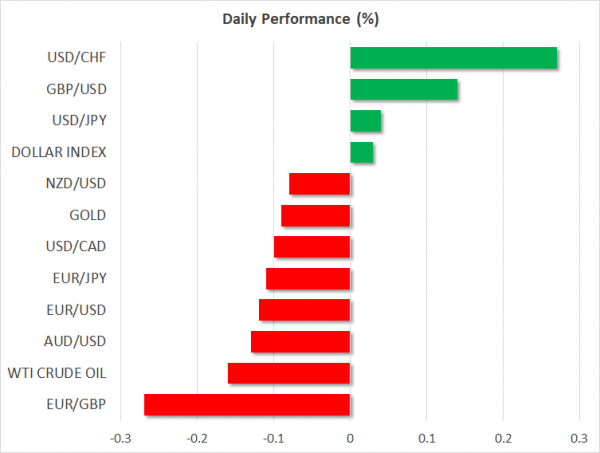Here are the latest developments in global markets:
- FOREX: The dollar’s index against a basket of currencies reversed earlier losses to trade marginally higher on the day. The British pound continued to outperform on the back of rising hopes for a Brexit deal, though it reversed a considerable portion of earlier gains against both the dollar and the euro. Indicatively, GBPUSD traded below the 1.30 handle after previously hitting a two-week high of 1.3062. The UK came on the receiving end of weaker-than-anticipated services PMI data, with the index coming in at 52.2, its weakest since July 2016, immediately after the Brexit referendum. However, the main driving force for the currency is and will most probably continue to be any developments on Brexit. EURUSD was 0.1% lower at 1.1371. Earlier on the day, the Sentix index that gauges investor sentiment in the euro area disappointed in November, falling to its lowest since October 2016. Elsewhere, it is interesting that the dollar is higher against both the yen and the franc which are considered as safe-haven currencies. One might have expected the two to receive some inflows on cautiousness ahead of the US midterms. Yield differentials in the favor of the US are perhaps dominating such concerns at the moment.
- STOCKS: Excluding the Italian FTSE MIB and the Swedish OMX 30, that were both down by 0.4%, major European benchmarks were in the green at 1240 GMT. Italian equities were negatively affected after Goldman Sachs downgraded big banks in the country to “sell”. The pan-European Stoxx 600 was up by 0.2% and the blue-chip Euro Stoxx 50 traded higher by 0.3%. The UK’s FTSE 100, the German DAX and the French CAC 40 were up by 0.5%, 0.2% and 0.2% correspondingly. The move up in Europe is notable, especially in light of sharp losses for Asian equities earlier on Monday and Wall Street’s declines on Friday on the back of angst over the Sino-US trade dispute and rising US yields. Brexit and the US midterms are other factors that can affect equity market sentiment as the week unfolds. Futures on the Dow, S&P 500 and Nasdaq 100 recovered to now project a more or less flat open for these benchmarks.
- COMMODITIES: WTI fell by around 0.2%, extending its losses from previous days to trade not far above $62.52 per barrel, its lowest since April touched earlier on Monday. US sanctions on Iran went back into effect today, though the granting of temporary waivers to major buyers that allows them to continue purchasing Iranian oil has weighed on prices. Moreover, Tehran said it would defy US actions and continue selling as previously. Brent crude was near flat, at $72.87/barrel. In precious metals, gold was slightly down, trading at roughly $1,231.00/ounce.
Day ahead: US ISM non-manufacturing PMI, RBA decision coming up; Barnier to deliver Brexit speech
The ISM’s non-manufacturing PMI will be hitting the markets in the early hours of US trading. Beyond this and during Tuesday’s Asian session, the Reserve Bank of Australia (RBA) will be deciding on rates, while Japanese household spending figures are also slated for release. Elsewhere, the EU’s chief Brexit negotiator Michel Barnier will be delivering a speech on Brexit.
At 1500 GMT, the US ISM non-manufacturing PMI will be made public. The gauge is anticipated to fall from September’s 61.6, the highest since the index’s creation in 2008, to 59.3, which would also be a robust print. Barring a significant deviation from expectations, the release is not likely to prove a major market-mover. Meanwhile, politics are taking center stage in the US, with the midterm elections concluding on Tuesday.
A risk-event for sterling will be Barnier’s Brexit speech set to take place in Brussels at 1930 GMT. Should he reinforce the reports suggesting progress on Brexit negotiations, then the pound is likely to extend its recent gains versus major currencies, including the dollar and the euro. If instead he focuses on the impediments that hold the two sides away from a Brexit deal, then the British currency is expected to retreat.
Back on the data-front, Japanese household spending figures are due at 2330 GMT. Spending is projected to have contracted on a monthly basis in September after recording an unexpected jump in August.
Having more potential to prove market-moving during Tuesday’s Asian session will be the RBA’s policy decision due at 0330 GMT. The central bank is widely anticipated to yet again maintain its benchmark rate at a record low of 1.5%. In light of this, the Bank’s communication – how optimistic it is on the economy – is expected to dictate the Aussie’s movement in the aftermath of the decision.
ECB Vice President de Guindos and the Bank’s Chief Economist Praet will be speaking in Brussels, where eurozone finance ministers will also be meeting to discuss euro area integration.
Lastly, global trade considerations remain in the background with any updates having the capacity to rattle the markets. There was some optimism for de-escalating tensions between the US and China last week that spurred risk-on trades, though White House economic advisor Kudlow later downplayed the odds for a quick deal with China. For the record, Presidents Trump and Xi will be meeting at the G20 summit at the end of the month.















